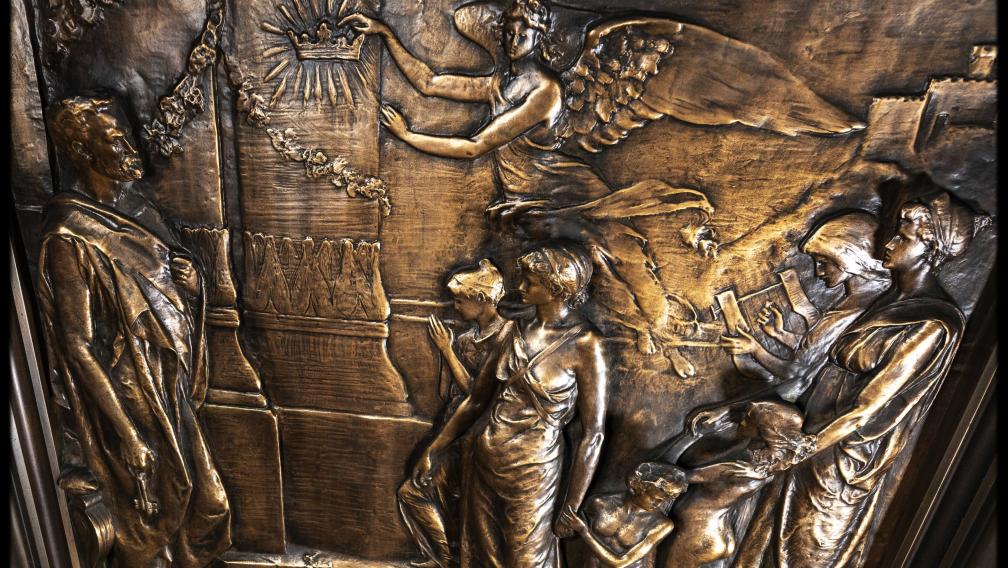Trinity's North Bronze Doors

For years, thousands of people have visited Trinity Church Wall Street and St. Paul’s Chapel, as both pilgrims and tourists. Summer usually generates even more interest as vacationers come to Lower Manhattan to learn more about the parish and how Trinity’s history reflects that of New York City and even the United States.
From now until Labor Day, Trinity is sharing stories especially for visitors, to maximize their experience, whether they have an hour, a day, or an entire week to explore the church, the chapel, and the churchyards.
Our first article examining the Astor Memorial Doors focused on the bronze doors at the south entrance. The doors on the north side of the church take a different approach to imagery and, for the visitor, the images deserve and require an investment of time to study them. While the south doors recall the history of New York City and Trinity Church Wall Street, the north doors, as well as the two that face east, focus on spiritual, mostly Bible-based themes. (Photos by Leo Sorel and Colin Winterbottom).
Creative responsibility for the north bronze doors fell to the sculptor J. Massey Rhind (1860-1936), an immigrant from Scotland. While all three sets of doors address the theme of “Thou didst open the Kingdom of Heaven to all believers,” (from the hymn "Te Deum")Massey’s specific focus was “Deliverance from Tribulation.”
Designed to be viewed from the bottom up, in the tradition of medieval stained-glass art, the six images of the north bronze doors begin with a scene showing the Israelites, at Moses’ direction, sprinkling the blood of a lamb on the lintels and doorposts of their homes so that the destroying angel will pass over them, thus providing deliverance, through the opportunity to escape Egypt for freedom in the Promised Land.
The next image portrays "cities of refuge," six of them are mentioned in the Biblical text, where anyone who had accidentally or inadvertently killed another person could flee, and would be granted safety and asylum.
Another portal, not a door but rather a “Beautiful Gate,” is Rhind’s next image, recalling a deliverance from a personal physical condition, the story of St. Peter and St. John invoking the name of Jesus to heal a lame man who immediately stands up and walks.
It’s not St. Peter, but rather St. Paul who shows up next, with Silas, after the door of the jail in Philippi in which they were incarcerated for disturbing the peace has been opened by the force of an earthquake. Paul and Silas are delivered from imprisonment, and the dramatic event leads the jailer to a conversion of faith.
The top two images both include St. Peter. The first, based on a text from the Book of Revelation, shows Peter with a set of keys to the Kingdom of Heaven, with a line of people waiting to be admitted as the ultimate example of deliverance.
The final image of Peter is not scriptural but represents a traditional story passed down in the Church. As Peter fled Rome because he was believed to be in danger from the authorities of the empire, he encounters Jesus, asking: “Lord, where are you going?” (Domine, quo vadis?) Jesus tells Peter he’s headed to Rome to be crucified again, at which point Peter returns to Rome, where he himself is martyred.
Observers have noted that Rhind was not only providing images for two doors. In at least five of the six images, he’s using a variety of portals, both doors and gates, to demonstrate deliverance. The theme is summarized with the image and the scripture verse “I am the door of the sheep” in the tympanum above the doors (see photo below).
Since the completion of the Astor Memorial Doors in the 1890s, the east-facing doors have likely received the most attention, since they stand at the primary entrance to Trinity Church Wall Street on Broadway. Those bronze doors will be the subject of our next article in this summer visitor experience.